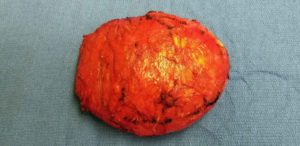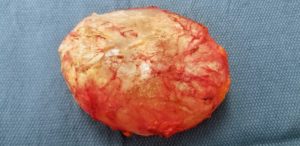Quick Facts About Capsulectomy
- Principle Benefits: A capsulectomy involves the removal of scar tissue (capsule) that forms around breast implants, addressing issues such as capsular contracture, breast implant illness (BII) and other implant-related concerns.
- Treatment Overview: The procedure is typically performed under general anesthesia and can involve a partial, total or en bloc capsulectomy, depending on the patient’s needs. It is often combined with implant removal (explantation), implant exchange or a breast lift.
- Recovery Timeline: Most patients require about 1-2 weeks of downtime for initial recovery. Swelling and bruising gradually subside over the following weeks, with full healing taking up to around a year. Drains are typically placed to facilitate fluid removal and are typically removed within a one to two weeks.
- Average Cost: According to patient data from RealSelf, the average cost of an en bloc capsulectomy is around $11,082, though for a typical capsulectomy it is substantially less and the en bloc technique is not indicated in all cases. Additionally, that price may not reflect all associated fees or whether any additional procedures were performed in conjunction with the capsulectomy. A custom price quote can be provided to you following a consultation with Dr. Turkeltaub.
The term “capsulectomy” is generally used in relationship to some untoward issues that relate directly to breast implants. In the past, it was used in regards to “hard” breasts associated with capsular contracture. Nowadays, it has also been applied to other breast implant problems that have been receiving some substantial coverage on the internet, including on social media.
Let’s explore this in more detail.
- What is a Capsulectomy?
- What are the Indications for a Capsulectomy?
- Are There Different Types of Capsulectomies?
- Can Capsulectomies Be Performed in Combination with Other Breast Procedures?
- Needing a Capsulectomy?
What is a Capsulectomy?
A capsulectomy is the surgical procedure that removes the scar tissue, known as a capsule, which naturally forms around breast implants. A capsule develops with both saline and silicone breast implants including smooth and textured surfaced ones. In fact, this scar tissue forms around any “foreign” material placed in the body such as orthopedic implants and pacemakers. It also is extremely common in women who have undergone breast reconstruction with implants and have had radiation treatments.
In normal situations, the capsule is thin, soft and pliable and has no impact on the movement, feel and appearance of the breast implants. However, when the capsule starts squeezing and contracting around the implant, it causes hardness, deformity and, in relatively rare situations, pain. It can also become significantly thick, further compounding the problem.
- Bilateral Capsulectomies with Implants
By surgically excising this capsule with a capsulectomy, the capsular contracture can be effectively treated. In breasts that have been irradiated in the treatment of breast cancer, the situations are not quite straightforward.
What are the Indications for a Capsulectomy?
The most common indications or requests for a capsulectomy are in the treatment of:
- Capsular contracture
- Breast implant-associated anaplastic large cell lymphoma (BIA-ALCL)
- Breast implant illness (BII)
Capsular contracture is where one or both breasts feel firm or hard—sometimes to the point that it can be not only problematically deforming but also painful. This occurred far more commonly in the past than it does now and for a variety of reasons. There is a higher rate of development with implants placed in a submammary (behind the breast tissue but in front of the muscle) versus a submuscular (behind the chest wall muscle) and with the infra-areolar incision versus the inframammary incision.
The overwhelming majority (95% +) of capsulectomies performed by plastic surgeons are for capsular contracture. This procedure can be combined with either an implant exchange or explantation.
A total capsulectomy is the prescribed surgical treatment of breast implant-associated anaplastic large cell lymphoma (BIA-ALCL) though this is an extremely rare disease worldwide. (As of October 2019, there were less than 600 cases diagnosed worldwide out of more than 10–12 million or more who have breast implants.)
Finally, there is a non-specific constellation of symptoms experienced by some women with breast implants which has been referred to as breast implant illness (BII). Self-anointed experts, facilitated by numerous postings and aggressive online marketing, have strongly recommended surgical treatment of this “condition” with en bloc capsulectomies (see section below). Unfortunately, there is absolutely no scientific evidence yet to support this recommendation but there are some patients who have taken this as gospel and are now demanding that this specific procedure be performed.
Are There Different Types of Capsulectomies?
There are three types of capsulectomies:
- Partial capsulectomy
- Total capsulectomy
- En bloc capsulectomy
A partial capsulectomy is the surgical removal of some but not all of the capsule. For example, it is not uncommon to have sections or parts of the capsule left on the chest wall or left on the deep surface of the skin where it may be extremely thin. In such situations, it may be either unnecessary to remove the whole capsule or the risks in attempts to remove it outweigh any possible advantage of its removal.
The total capsulectomy involves the complete excision of the capsule around the implant. Most often, the removal is not performed in one piece but in several and for a variety of reasons including safety, technical difficulty or the physical nature of the capsule itself.
When a total capsulectomy is performed by removal of the capsule as an intact unit that also contains the implant, this is called an en bloc removal. Some situations lend themselves to better facilitate this approach. In either event, the entire capsule is resected.
- En Bloc Capsulectomy
- En Bloc Capsulectomy
Some patients request/insist that their capsulectomies be performed using this en bloc approach and this is based on information that they hear or read about, largely originating from internet postings from self- appointed “experts.” The reality is that there is absolutely no reputable scientific evidence that this approach is substantially superior to the generic total capsulectomy technique.
Can Capsulectomies Be Performed in Combination with Other Breast Procedures?
Most commonly, capsulectomies are performed as part of either an explantation or implant exchange. Either the associated implants are removed permanently (explantation) or new ones of the desired characteristic are placed at the same time (breast revision or implant exchange). Regardless, drains are placed as part of the surgical procedure and are removed within several days or longer.
Depending on patient desires and other factors, a breast lift or even a breast reduction can also be performed at the same time.
Needing a Capsulectomy?
If you are in need of a capsulectomy, for whatever reason, you can contact our office for further information and to schedule your consultation.








